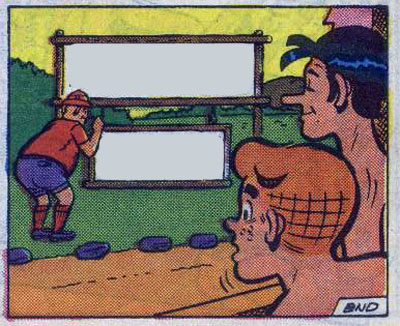
19
Jan
Supposedly Not Improved Archie
Posted by MGK Published in Archie (Improved Or Otherwise), Comics, Interactive Fun Time Party
5
Jan
Improved Archie Ultra-Lite
Posted by MGK Published in Archie (Improved Or Otherwise), Comics, Interactive Fun Time Party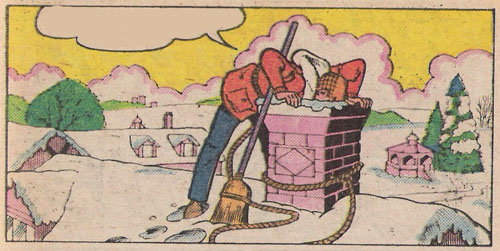
14
Dec
Diet Improved Archie (With Lime!)
Posted by MGK Published in Archie (Improved Or Otherwise), Comics, Interactive Fun Time Party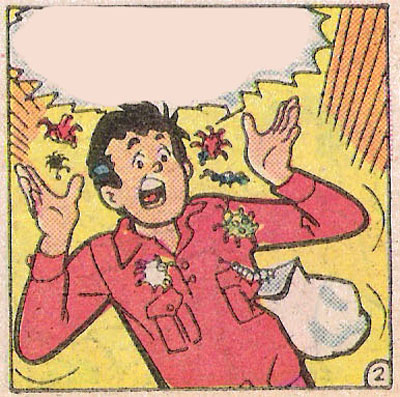
1
Dec
Theoretically Not Improved Archie
Posted by MGK Published in Archie (Improved Or Otherwise), Comics, Interactive Fun Time Party
16
Nov
I Can’t Believe It’s Not Improved Archie
Posted by MGK Published in Archie (Improved Or Otherwise), Comics, Interactive Fun Time Party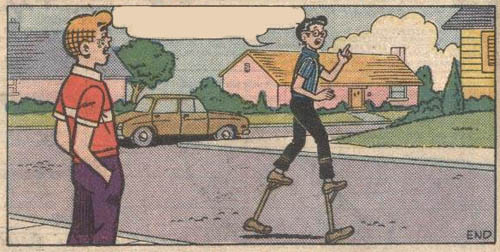
2
Nov
Not Necessarily Improved Archie
Posted by MGK Published in Archie (Improved Or Otherwise), Comics, Interactive Fun Time Party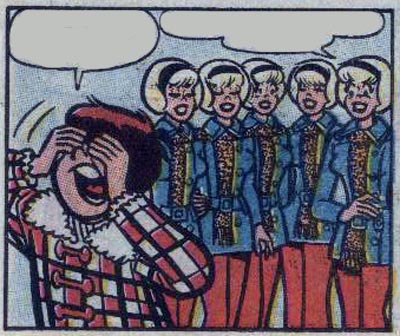
19
Oct
I Can’t Believe It’s Not Improved Archie
Posted by MGK Published in Archie (Improved Or Otherwise), Comics, Interactive Fun Time Party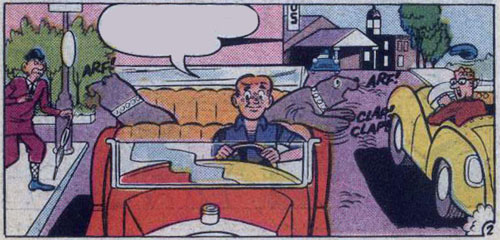
5
Oct
Not Quite Improved Archie
Posted by MGK Published in Archie (Improved Or Otherwise), Comics, Interactive Fun Time Party
21
Sep
Not Quite Improved Archie
Posted by MGK Published in Archie (Improved Or Otherwise), Comics, Interactive Fun Time Party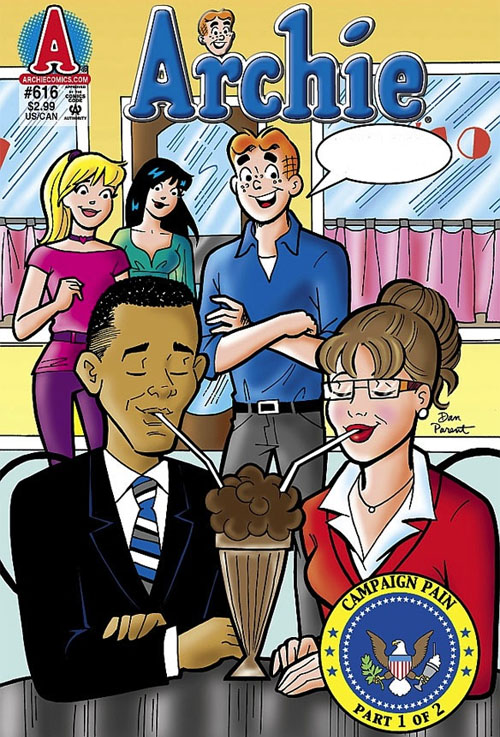
8
Sep
Not Quite Improved Archie
Posted by MGK Published in Archie (Improved Or Otherwise), Comics, Interactive Fun Time Party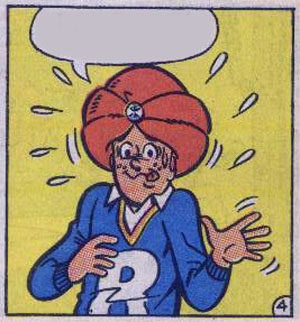
6
Sep
Betty Cooper Insanity, Postwar Division
Posted by Jaime Weinman Published in Archie (Improved Or Otherwise), Comics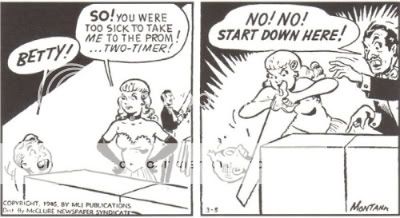
Of IDW’s recent Archie comics collections, Archie: The Daily Newspaper Comics 1946-1948 is by some distance the best. First, it’s a real collection; it has all the daily strips written and drawn by Archie creator Bob Montana (who mostly concentrated on the strip, rather than the comic books, until his death in 1975) from the beginning in 1946 until October 1948, and nearly all of them have never appeared in book form — in fact, the originals are gone, and IDW had to find a fan who’d cut all these strips out of the original newspapers. Second, it’s got actual information to go with the comics: biographical stuff about Montana and MLJ Comics.
And third, the strip is good. It later became a funny but standard gag-a-day strip, but in the early years Montana did story arcs, some of them lasting for weeks, along with the individual gags. The energy of his drawing and writing is hard to resist; as the foreword points out, he liked to throw in jokes throughout the strip rather than just using the first three panels as buildup to a punchline. And because the series creator was doing the newspaper comics — which were more prestigious than the books — it was there that the characters really developed both in characterization and look; you can watch as he starts out with the more realistic early versions of the girls in 1946, and has the cartoony “modern” versions more or less down by the end of the book. (It’s something of a myth that Dan DeCarlo modernized the looks of the characters, though he certainly brought his own style to them.) Just as a comic strip, this certainly deserves its spot with the other entries in IDW’s “Library of American Comics” series, though since one of the other entries is The Family Circus you may consider that less than effusive praise (but that strip wasn’t bad at first).
In an anthropological sense it’s interesting to see which characters were more or less set in stone by these strips, and which ones were further developed by the comic books. Archie is pretty much Archie from the beginning, but Jughead still has a long way to go even by the end of this book: he didn’t become a genius con artist until he got his own book, and spends these years as mostly a standard sidekick. Dilton Doily pops up midway through and is fully defined by the end.
But what most of you really want to know is, were Betty Cooper’s psychotic tendencies something that she developed later after years of Archie-chasing, or just an inherent part of who she is? This should answer your question.

This isn’t actually her acting crazy, just ditzy, but I’m amused by the name of the girls’ football team and Reggie’s competing team.
If you’re wondering why Archie isn’t too concerned about Betty’s threats of physical harm (not to mention that warning shot into Jughead), you’ll find that out if IDW puts out a second volume of strips. As a strip from 1949 proves, Archie and Bart Simpson are both victims of casual parental strangling that would make anyone desensitized to violence.

A few Sunday strips by Montana (not included in this book) can be found at The Greatest Ape. Which also includes the daily strip which demonstrates what is known to all viewers of Looney Tunes cartoons: the defining characteristic of teenage girls in 1940s America was addiction to Frank Sinatra.
Update: A couple of other panels I wanted to highlight. One, also from the football-coach storyline, I just like because it’s the kind of deadpan Stan Daniels Turn joke that I always like, and second because it shows how Montana would sometimes put a fully-developed punchline in the first panel of the strip (which this is).

And this other panel surprised me because I hadn’t realized this word was uncontroversial in 1947 — or did it mean something else back then?

4
Aug
Not Quite Improved Archie
Posted by MGK Published in Archie (Improved Or Otherwise), Comics, Interactive Fun Time Party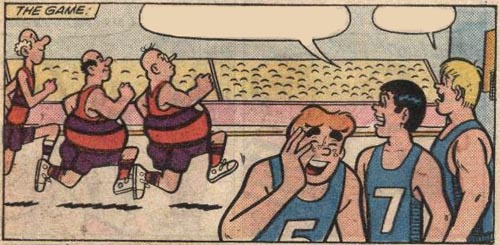
20
Jul
Not Quite Improved Archie
Posted by MGK Published in Archie (Improved Or Otherwise), Comics, Interactive Fun Time Party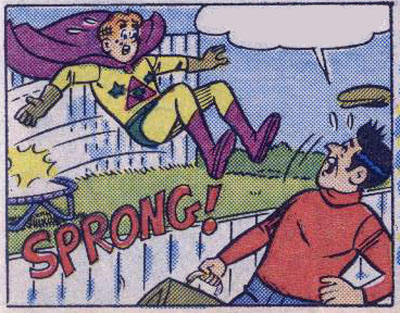
7
Jul
Not Quite Improved Archie
Posted by MGK Published in Archie (Improved Or Otherwise), Comics, Interactive Fun Time Party
25
Jun
Dan! Dan! He’s Our Boy! If He Can’t Draw It, No One… Will
Posted by Jaime Weinman Published in Archie (Improved Or Otherwise), ComicsI picked up IDW’s first Archie Comics collection, The Best of Dan DeCarlo Volume 1. Since no one has yet posted a list of the contents, I thought I’d have a go at it.
Before I do, I’ll give some brief thoughts: the biggest quibble is that there are only 26 stories here, and they barely scratch the surface of DeCarlo’s output in the years 1958-1969. It’s limited to Betty and Veronica stories (DeCarlo had that almost exclusively, but also contributed to many other titles), and while almost all of them are good, not all of them can really be called standouts. However, I’m assuming that the choice of stories was dictated in part by which stories had original art available. Many of these stories look lovely, especially the late ’50s/early ’60s material when DeCarlo was at his best, and a comparison with an old copy of one of the comics seems to suggest that they’ve done a good job of reproducing the original colours.
The most pleasing thing, as I said elsewhere, is that the table of contents includes credits for all the stories, which originally appeared uncredited. DeCarlo got to sign his name alongside Stan Lee’s when he was at Marvel, doing Millie the Model, but at Archie he never got credit for anything except a tiny “By Dan n’ Dick” credit on some of the Josie comics. (Dick being the editor, Richard Goldwater.) That restores credit not only for DeCarlo, but for his main inker, Rudy Lapick, for his brother Vince DeCarlo, who did most of the letters, and above all Frank Doyle, who is credited here with writing 23 of the 26 stories — and the story for which the credit reads “writer unknown” might also be a Doyle script.
I’ve always been a fan of Doyle ever since I read his credited work in the ’80s, but his earlier, uncredited work is even better; it’s his writing that really elevates the best of these stories. DeCarlo is excellent here, sexy and funny and smooth, though by the end of the volume you can see how his slickness and polish sort of settled into a “factory” style (the early stories have much livelier and funnier drawing). But his drawing for Archie wasn’t any better than his work for Timely/Marvel, and if you want to argue that Millie the Model represents his very best drawing, I wouldn’t really disagree. But though Stan Lee’s writing on the Marvel/Timely humor titles certainly wasn’t bad, Doyle’s best stuff is in a different league (from Lee’s humour comics, I said — I’m not talking about the action/superhero stuff), with simple yet smart dialogue that’s not on-the-nose awkward like most comic book dialogue, a storytelling style that favours observational humour over plot mechanics, and lots of visual opportunities for DeCarlo.
I’ve compared Doyle’s work to “Seinfeld” because, on a smaller scale, he has that ability to build stories around tiny details of social life and relationships, or the way people can get obsessed with petty things. (That’s why the stories sound pretty basic when I summarize them, but have a much stronger profile when you read them.) The definitive story in the book, “Snob Sister,” is just five pages of Veronica showing Betty the different ways in which people can be “snobbish.” It’s simple, it’s fun, and it just comes off as a little smarter and sharper than any of the Archie imitators of the era.
So yes, there are a bunch of stories I would have liked to see in this volume that aren’t there. And fans of “good girl” art may be a bit disappointed that there are so few beach stories. But if you’re not a buff on this kind of comic, it’s a reasonably-priced introduction to DeCarlo’s art and the “good” years of Archie comics in general. And the decision to include credits is, as I said, something that fills me with a lot of good will. IDW has further Archie collections planned, including Bob Montana’s newspaper strip — which is where the Archie “house style” was really created — and a “Best of Stan Goldberg” collection with Stan Lee writing the foreword (this volume doesn’t have a foreword). I hope this one sells enough to justify more artist-themed collections and, in time, perhaps more DeCarlo collections; we really need a collection of his best post-Marvel work, the early, funny, pre-Pussycats Josie.
Here then are the contents. All scripts are by Frank Doyle unless otherwise noted:
1. “Birth of a Notion” (Betty and Veronica # 37, July 1958) – The boys toss around a doll and fool the girls into thinking they’re tossing around a baby. (Script: Sy Reit)
2. “Flip Flopped” (Betty and Veronica # 38, September 1958) – Veronica signs up for the cheerleading squad.
3. “Sheep Skinned” (Betty and Veronica # 44, August 1959) – The boys accuse the girls of being “sheep” for following the latest fashions.
4. “A Choice Choice” (Betty and Veronica Annual # 8, 1960) – Archie has to break his date with Veronica to take his mother out on her birthday.
5. “Something to Remember” (Betty and Veronica # 63, March 1961) – Veronica is peeved because Archie can never remember what she wears.
6. “The Reader Knows Best” (Betty and Veronica # 63) – Archie tries to do the same task for both Betty and Veronica, while assuring the reader that he knows what he’s doing.
7. “The Bluest Angel” (Betty and Veronica # 63) – Betty feels guilty about exploiting a misunderstanding between Archie and Veronica.
8. “Gambler’s Luck” (Betty and Veronica # 65, May 1961) – The girls toss a coin to see who gets Archie.
9. “Snob Sister” (Betty and Veronica # 69, September 1961) – Veronica argues that everyone is a snob about something or other.
10. “Switchcraft” (Betty and Veronica # 69) – Veronica thanks Betty for taking Archie off her hands.
11. “The Original” (Betty and Veronica # 77, May 1962) – Veronica explains that she doesn’t wear real jewels in public. (Credit reads “Writer unknown,” though it might also be Doyle)
12. “Commercial Caper” (Betty and Veronica # 83, November 1962) – Betty blows up “Archie Loves Betty” balloons.
13. “Glad To Help” (Betty and Veronica # 86, February 1963) – Archie tries to use Betty to make Veronica jealous.
14. “Dear Diary” (Archie Giant Series # 23, September 1963) – Betty writes her version of the day’s events in her diary.
15. “Sugar Doll” (Betty and Veronica # 103, July 1964) – Veronica tries to make candy.
16. “Heat Wave” (Betty and Veronica # 106, October 1964) – Archie, Betty and Veronica spend a hot day squirting each other with hoses.
17. “Bully Girl” (Betty and Veronica # 106) – Veronica shows off her new martial arts skills by beating up everyone in sight.
18. “The Midas Mess” (Betty and Veronica # 112, April 1965) – Everything Betty touches turns to gold.
19. “Prize Package” (Betty and Veronica # 112) – Betty tells Archie he’s won a “most popular boy” contest.
20. “Message Center” (Betty and Veronica # 116, August 1965) – Betty sees a message on the bulletin board saying Miss Grundy wants to see her after school.
21. “The Phenomenon” (Betty and Veronica # 117, September 1965) – Betty and Archie discover that when Veronica stands on her head, her speech balloons are upside down.
22. “Rhyme Time” (Betty and Veronica # 119, November 1965) – The narrator re-introduces us to the Archie gang, in rhyme.
23. “Do No Evil” (reprinted in Archie Giant Series # 137, January 1966 — but from the look of it it’s clearly an earlier story, probably from 1960 or so) – After the girls accuse them of being slobs, Archie and Reggie try to get revenge.
24. “Feed Deed” (Betty and Veronica # 130, October 1966) – At the beach, Veronica tries to outdo Betty’s cooking. (Script: George Gladir)
25. “Wing It” (Betty and Veronica # 155, November 1968) – Betty impresses the boys with her great throwing arm.
26. “Drive To Distraction” (Betty and Veronica # 167, November 1969) – Archie uses a beach umbrella to give Veronica some shade in his car.
Search
"[O]ne of the funniest bloggers on the planet... I only wish he updated more."
-- Popcrunch.com
"By MightyGodKing, we mean sexiest blog in western civilization."
-- Jenn
Contact
MGKontributors
The Big Board
MGKlassics

Blogroll
- ‘Aqoul
- 4th Letter
- Andrew Wheeler
- Balloon Juice
- Basic Instructions
- Blog@Newsarama
- Cat and Girl
- Chris Butcher
- Colby File
- Comics Should Be Good!
- Creekside
- Dave’s Long Box
- Dead Things On Sticks
- Digby
- Enjoy Every Sandwich
- Ezra Klein
- Fafblog
- Galloping Beaver
- Garth Turner
- House To Astonish
- Howling Curmudgeons
- James Berardinelli
- John Seavey
- Journalista
- Kash Mansori
- Ken Levine
- Kevin Church
- Kevin Drum
- Kung Fu Monkey
- Lawyers, Guns and Money
- Leonard Pierce
- Letterboxd – Christopher Bird - Letterboxd – Christopher Bird
- Little Dee
- Mark Kleiman
- Marmaduke Explained
- My Blahg
- Nobody Scores!
- Norman Wilner
- Nunc Scio
- Obsidian Wings
- Occasional Superheroine
- Pajiba!
- Paul Wells
- Penny Arcade
- Perry Bible Fellowship
- Plastikgyrl
- POGGE
- Progressive Ruin
- sayitwithpie
- scans_daily
- Scary-Go-Round
- Scott Tribe
- Tangible.ca
- The Big Picture
- The Bloggess
- The Comics Reporter
- The Cunning Realist
- The ISB
- The Non-Adventures of Wonderella
- The Savage Critics
- The Superest
- The X-Axis
- Torontoist.com
- Very Good Taste
- We The Robots
- XKCD
- Yirmumah!
Donate
Archives
- August 2023
- May 2022
- January 2022
- May 2021
- January 2021
- December 2020
- October 2020
- June 2020
- March 2020
- January 2020
- December 2019
- October 2019
- February 2019
- January 2019
- December 2018
- April 2018
- March 2018
- February 2018
- January 2018
- December 2017
- November 2017
- October 2017
- February 2017
- January 2017
- December 2016
- November 2016
- October 2016
- September 2016
- August 2016
- July 2016
- June 2016
- May 2016
- April 2016
- March 2016
- February 2016
- January 2016
- December 2015
- November 2015
- October 2015
- September 2015
- August 2015
- July 2015
- June 2015
- May 2015
- April 2015
- March 2015
- February 2015
- January 2015
- December 2014
- November 2014
- October 2014
- September 2014
- August 2014
- July 2014
- June 2014
- May 2014
- April 2014
- March 2014
- February 2014
- January 2014
- December 2013
- November 2013
- October 2013
- September 2013
- August 2013
- July 2013
- June 2013
- May 2013
- April 2013
- March 2013
- February 2013
- January 2013
- December 2012
- November 2012
- October 2012
- September 2012
- August 2012
- July 2012
- June 2012
- May 2012
- April 2012
- March 2012
- February 2012
- January 2012
- December 2011
- November 2011
- October 2011
- September 2011
- August 2011
- July 2011
- June 2011
- May 2011
- April 2011
- March 2011
- February 2011
- January 2011
- December 2010
- November 2010
- October 2010
- September 2010
- August 2010
- July 2010
- June 2010
- May 2010
- April 2010
- March 2010
- February 2010
- January 2010
- December 2009
- November 2009
- October 2009
- September 2009
- August 2009
- July 2009
- June 2009
- May 2009
- April 2009
- March 2009
- February 2009
- January 2009
- December 2008
- November 2008
- October 2008
- September 2008
- August 2008
- July 2008
- June 2008
- May 2008
- April 2008
- March 2008
- February 2008
- January 2008
- December 2007
- November 2007
- October 2007
- September 2007
- August 2007
- July 2007
- February 2007
Tweet Machine
- No Tweets Available
Recent Posts
- Server maintenance for https
- CALL FOR VOTES: the 2021 rec.sport.pro-wrestling Awards
- CALL FOR NOMINATIONS: The 2021 rec.sport.pro-wrestling Awards (the Theszies)
- The 2020 RSPW Awards – RESULTS
- CALL FOR VOTES: the 2020 Theszies (rec.sport.pro-wrestling Awards)
- CALL FOR NOMINATIONS: The 2020 Theszies (rec.sport.pro-wrestling awards)
- given today’s news
- If you can Schumacher it there you can Schumacher it anywhere
- The 2019 RSPW Awards – RESULTS
- CALL FOR VOTES – The 2019 RSPW Awards (The Theszies)
Recent Comments
- Blob in How Jason Todd Went Wrong A Second Time
- Cindi Chesser in Thursday WHO'S WHO: The War Wheel
- Scott Hater in Bing, Bang, Bing, Fuck Off
- dan loz in Hey, remember how we talked a while a back about b…
- Sean in Server maintenance for https
- Ethan in CALL FOR VOTES: the 2021 rec.sport.pro-wrestling A…
- wyrmsine in ALIGNMENT CHART! Search Engines
- Jeff in CALL FOR VOTES: the 2021 rec.sport.pro-wrestling A…
- Greg in CALL FOR VOTES: the 2021 rec.sport.pro-wrestling A…
- DragoMaster009 in Grading Every Country's National Anthem, Part Four…





